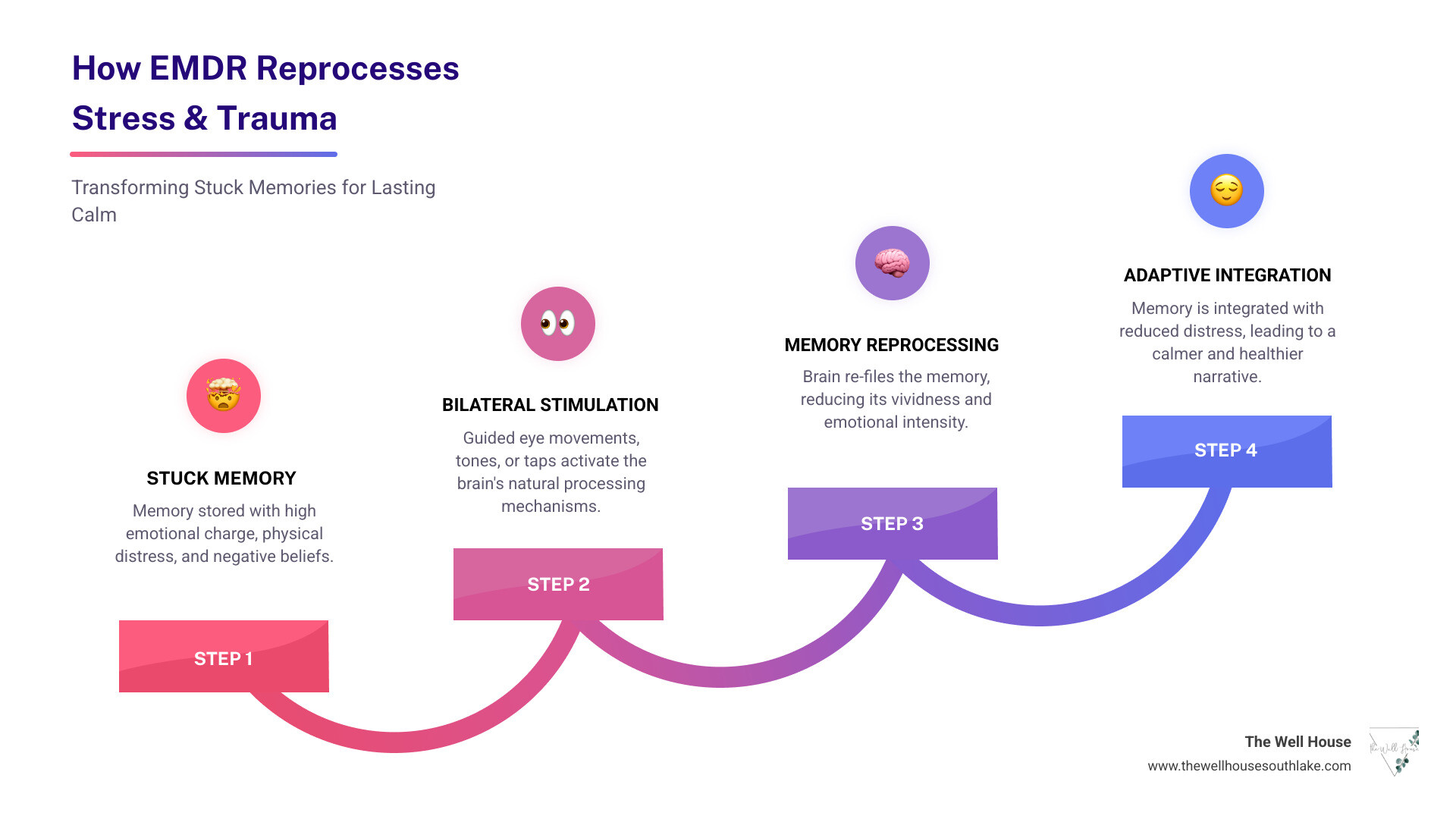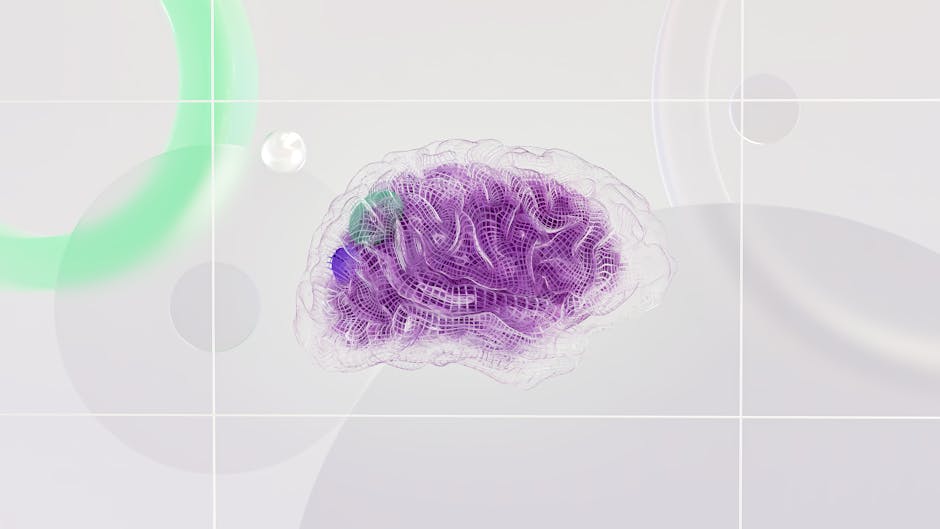Unlock Your Calm: A Guide to EMDR Therapy for Stress and Trauma
Why EMDR for Stress Matters: A Path to Healing
Do you ever feel stuck? Like worries won’t quiet down, old hurts keep replaying, and stress has become your baseline. You’re not alone.
Stress and trauma don’t just live in our thoughts; they get stored in our bodies and nervous systems. When a distressing event occurs, the memory can get “stuck,” leaving our bodies responding as if the danger is still present. This is where EMDR for stress comes in. It’s a structured therapy that helps your brain reprocess these experiences, reducing their emotional charge so you can feel calmer and more in control.
Here’s what you need to know about Eye Movement Desensitization and Reprocessing (EMDR):
- What it is: EMDR uses bilateral stimulation (like eye movements or tapping) to help your brain process stuck memories.
- How it helps: It reduces the emotional intensity of stressful memories, often faster than talk therapy, and can be combined with techniques like emdr and mindfulness.
- Who it’s for: Anyone needing counseling for trauma, including those with PTSD, anxiety, phobias, or emdr complex trauma.
- Evidence-based: Endorsed by the WHO and American Psychiatric Association as effective for trauma.
This guide will walk you through what EMDR is, how it works, the 8-phase process, and who can benefit.
I’m Jennifer Kruse, a Licensed Professional Counselor Supervisor with over 20 years of experience. I’ve seen how powerful EMDR can be in helping clients—especially busy mothers—refind peace and clarity. Let’s explore how this therapy could help you.

Understanding EMDR: From Stress Relief to Trauma Healing
In 1987, psychologist Dr. Francine Shapiro made a remarkable findy while walking in a park. She noticed that as her eyes moved back and forth, her own distressing thoughts began to lose their grip. This accidental finding led her to develop Eye Movement Desensitization and Reprocessing (EMDR). Dr. Shapiro dedicated her life to researching and refining this structured psychotherapy, which has now helped millions. You can read more about the life of Francine Shapiro and her legacy.
What makes EMDR unique is its use of dual-attention stimulation—often bilateral stimulation (BLS) like eye movements, alternating tones, or gentle tapping. This element helps the brain reprocess distressing memories, making EMDR for stress and trauma highly effective.
What is EMDR Therapy?
EMDR is a mental health treatment that helps you heal from the emotional distress of disturbing life experiences. Unlike traditional talk therapy, it doesn’t require you to describe every painful detail. Instead, it focuses on changing the way a memory is stored in your brain.
When a traumatic event happens, the memory can get “stuck” with all the original emotions and physical sensations. It’s like a wound that never healed. EMDR intervenes by having you briefly focus on the memory while experiencing bilateral stimulation. This dual attention helps your brain finally process and integrate the memory. The result? The memory loses its emotional intensity. It moves from being a raw, painful experience to something that happened in your past.
How Does EMDR Differ from Other Therapies?
If you’ve tried other therapies, EMDR might feel refreshingly different:
- You don’t have to talk through every detail. EMDR doesn’t require extensive verbalization of the trauma, which many find to be a relief.
- It often works faster. Many clients see improvement in just a few sessions, even for complex trauma, making EMDR for stress an efficient option for relief.
- There’s no homework. The reprocessing happens during the session with your therapist’s guidance.
- It’s a non-medication approach. EMDR offers a powerful way to heal without pharmaceuticals and has been shown to be more effective than certain medications for trauma.
- It’s gentler than prolonged exposure. You experience brief, interrupted exposures to the memory, which allows your brain to process without becoming overwhelmed.
This unique combination of reprocessing, efficiency, and managed exposure makes EMDR a distinctive pathway to healing. It’s about helping your brain file the memory away properly so it stops controlling your present.
The Science of Reprocessing: How EMDR Rewires the Brain for Calm

Why can a memory from years ago still make your heart race? The answer lies in how your brain stores experiences—and this is exactly what EMDR for stress is designed to address.
The theory behind EMDR is the Adaptive Information Processing (AIP) model. Think of it as your brain’s natural filing system. Normally, your brain processes experiences and files them away adaptively. But trauma or overwhelming stress can disrupt this system. The memory gets frozen in time, complete with the original emotions and physical sensations. It becomes “maladaptively stored,” which is why present-day triggers can make you feel like you’re reliving the event. You can read more about the scientific explanation of the AIP Model in research literature.
How EMDR Affects the Brain
EMDR helps facilitate communication between key brain regions that get disconnected during trauma:
- The amygdala (your brain’s alarm system) is calmed, reducing the constant state of high alert.
- The hippocampus (your brain’s librarian) is helped to properly catalog the memory, marking it as a past event.
- The prefrontal cortex (your brain’s CEO) regains control, allowing for reasoning and emotional regulation instead of panic.
The memory itself doesn’t disappear, but it loses its emotional charge. It becomes a chapter in your story, not a wound that keeps reopening.
The Role of Bilateral Stimulation
Bilateral stimulation (BLS)—the eye movements, tones, or taps—is a core component of EMDR. One leading theory is that it creates a dual-attention task. By focusing on both the memory and the BLS, your working memory is taxed, which reduces the memory’s vividness and emotional intensity.
Another theory suggests BLS mimics the eye movements of REM sleep, the phase when your brain naturally processes emotions and consolidates memories. EMDR may jumpstart this natural processing system in a guided, therapeutic setting.
It’s important to know that EMDR is not hypnosis. You remain fully conscious and in control throughout the session. The combination of focused attention and BLS gives your brain the tools to finally finish processing something it couldn’t handle at the time, leading to significant relief from emdr for stress and trauma symptoms.
Your Journey Through EMDR: The 8-Phase Process Explained
EMDR therapy is a collaborative journey that unfolds over eight carefully designed phases. Your therapist acts as a guide, ensuring you feel safe and in control as your brain does its natural healing work. The process moves at a pace that feels right for you.
The eight phases are: Phase 1: History-Taking and Treatment Planning; Phase 2: Preparation; Phase 3: Assessment; Phase 4: Desensitization; Phase 5: Installation; Phase 6: Body Scan; Phase 7: Closure; and Phase 8: Re-evaluation.
Phases 1-3: Preparation and Assessment
The first three phases build a strong foundation for healing.
- Phase 1: History-Taking and Treatment Planning: We discuss your story, current symptoms, and identify the target memories (past events, current triggers) we’ll address. This ensures EMDR is the right fit for you.
- Phase 2: Preparation: This crucial phase equips you with coping skills. We’ll teach you stress reduction techniques like grounding and the “Safe Place” exercise—a mental sanctuary you can use anytime you feel overwhelmed.
- Phase 3: Assessment: We zero in on a specific target memory. You’ll identify the image, the negative belief about yourself (e.g., “I’m not safe”), the emotions and physical sensations, and a positive belief you’d like to have instead.
What to expect during a session of emdr for stress?
We use two scales to track progress. The Subjective Units of Disturbance (SUD) scale (0-10) measures how disturbing a memory feels. The Validity of Cognition (VOC) scale (1-7) measures how true a positive belief feels. Our goal is to bring the SUD score down to 0 and the VOC score up to 6 or 7.
During reprocessing, you’ll hold the distressing memory in mind while engaging in bilateral stimulation. Your only job is to notice what comes up—thoughts, feelings, or sensations—without judgment. Your brain does the rest.
Phases 4-8: Reprocessing and Integration
This is where the core reprocessing work happens.
- Phase 4: Desensitization: While you focus on the target memory, your therapist guides you through sets of bilateral stimulation. We continue until the memory no longer causes significant distress (your SUD score drops).
- Phase 5: Installation: Once the distress is gone, we shift to strengthening the positive belief you identified earlier. We use more BLS to “install” this new, healthier belief until it feels true (your VOC score is high).
- Phase 6: Body Scan: We check for any remaining physical tension related to the memory. If any is found, we use more BLS to release it, ensuring complete mind-body healing.
- Phase 7: Closure: Every session ends with you feeling grounded and stable. We use calming exercises to ensure you feel contained before you leave, even if a memory isn’t fully processed.
- Phase 8: Re-evaluation: At the start of each new session, we check in on previously processed memories to ensure the positive changes have held and determine what to work on next. This keeps your therapy responsive to your needs and ensures lasting relief from emdr for stress.
The Efficacy of EMDR for Stress, PTSD, and Beyond

When considering a new therapy, you want to know: does it actually work? For EMDR, the answer is a resounding yes, backed by decades of research and endorsements from major health organizations.
The American Psychiatric Association, the World Health Organization (WHO), and the U.S. Departments of Veterans Affairs and Defense all endorse EMDR as an effective treatment for trauma. You can review the APA guidelines for PTSD treatment to see their detailed assessment. Many people see results faster than with traditional methods, and the benefits are long-lasting.
Who Can Benefit from EMDR Therapy?
While first known for treating Post-Traumatic Stress Disorder (PTSD), EMDR’s reach is much broader. It can help with the “quieter” traumas, too—an accumulation of stressful experiences, a difficult childhood, or persistent anxiety. We’ve seen its power across a range of struggles:
- PTSD and complex trauma
- Anxiety and panic attacks
- Depression rooted in past hurts
- Phobias with a traumatic origin
- Grief and loss
- Performance anxiety
- Chronic pain with an emotional component
- Addictions, by addressing underlying trauma
You don’t need a formal diagnosis. If you feel stuck by past memories or overwhelmed by life’s stressors, EMDR for stress can help.
How effective is emdr for stress and PTSD?
The research is compelling. Multiple systematic reviews, including a Cochrane review of PTSD therapies, have found EMDR to be a first-line treatment for PTSD.
The outcomes are remarkable:
- Studies show 84-90% of individuals with single-incident trauma no longer meet PTSD criteria after just three 90-minute sessions.
- A Kaiser Permanente study found that 77% of multiple-trauma victims were free of PTSD after six 50-minute sessions.
- Even 77% of combat veterans were free of PTSD after 12 sessions.
These statistics offer real hope that lasting healing from both diagnosed PTSD and the persistent emdr for stress of daily life is possible.
Frequently Asked Questions About EMDR Therapy

It’s normal to have questions when exploring a new therapy. Here are answers to some common concerns about emdr for stress and trauma treatment.
How long does EMDR therapy typically last?
Your timeline depends on your unique situation, but sessions usually last 50-90 minutes.
- For a single traumatic event, you might see significant resolution in as few as three to six sessions.
- For complex or long-term trauma, the journey typically takes eight to twelve sessions or more.
Many people start noticing improvement after just a few sessions. The benefits often continue to unfold even after therapy ends as your brain continues its natural healing. We’ll move at a pace that feels safe and effective for you.
Are there any risks, and is EMDR controversial?
Like any effective therapy, EMDR can bring up temporary discomfort, such as an increase in distress or vivid dreams between sessions. However, a trained EMDR therapist is skilled in managing these reactions and equips you with coping tools in the preparation phase. Most people find the lasting relief far outweighs any temporary discomfort.
As for controversy, the debate is not about if EMDR works—the evidence for its effectiveness is overwhelming—but why it works. Researchers are still exploring the exact mechanisms, but from a clinical perspective, what matters is that it helps people heal. The most important factor is working with a trained therapist who can ensure your safety and guide you through the process correctly.
Can I do EMDR by myself?
No. EMDR therapy should never be attempted on your own. Attempting to do so without a trained professional carries a serious risk of re-traumatization. You could become overwhelmed by distressing memories without the support needed to process them safely.
A certified EMDR therapist does much more than guide eye movements. They create a safe environment, teach coping skills, pace the session appropriately, and follow the structured eight-phase protocol to ensure comprehensive and safe healing. Your healing matters too much to risk. Please reach out to a qualified professional for safe, effective care.
Conclusion
EMDR for stress and trauma is a transformative path from feeling overwhelmed to experiencing genuine calm. It works with your brain’s natural ability to heal, helping it reprocess difficult memories so they no longer hijack your present. This isn’t about erasing your past, but about integrating it so you can move from surviving to truly living.
I know seeking help can feel vulnerable, but healing is possible. The research backs it up, and I’ve witnessed it countless times.
At The Well House, we believe in treating the whole person—mind, body, and spirit. Our team of diverse, certified EMDR therapists offers professional guidance and genuine care. We are here to walk alongside you, whether in person at our Southlake, TX office or through telehealth sessions across Texas.
If you’re ready to explore how EMDR for stress could help you, we’d love to hear from you. You can learn more about our EMDR services or reach out to schedule an initial consultation. Your journey toward calm can begin today.






